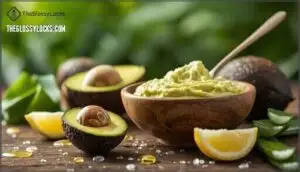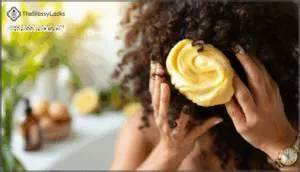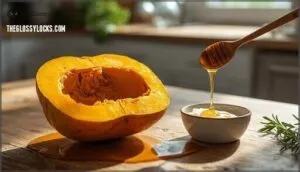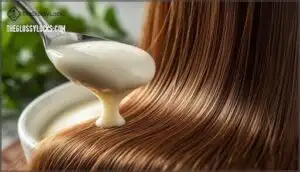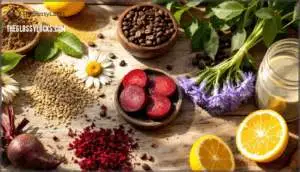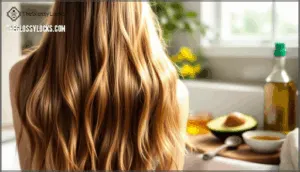This site is supported by our readers. We may earn a commission, at no cost to you, if you purchase through links.
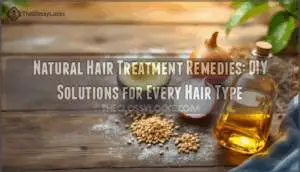
These treatments work at the cellular level, delivering vitamins, antioxidants, and fatty acids directly where follicles need them most. Whether you’re battling dryness, thinning, or split ends, these DIY remedies offer targeted solutions without harsh chemicals or expensive salon visits.
The key is matching the right treatment to your specific hair concern and understanding why each ingredient works the way it does.
Table Of Contents
- Key Takeaways
- Best Natural Remedies for Dry Hair
- Natural Solutions for Frizzy and Dull Hair
- DIY Remedies to Boost Hair Color Naturally
- Effective Treatments for Thinning Hair
- Simple Home Remedies for Split Ends
- Preventing Hair Loss Naturally
- Factors That Affect Hair Growth
- Frequently Asked Questions (FAQs)
- Conclusion
Key Takeaways
- Your kitchen holds powerful ingredients like avocado oil, onion juice, and fenugreek seeds that work at the cellular level to deliver vitamins, antioxidants, and fatty acids directly to hair follicles—backed by clinical research showing measurable improvements in moisture retention, regrowth rates, and strand strength.
- Onion juice stands out as a clinically proven treatment with an 86.9% regrowth success rate in alopecia cases after just six weeks, thanks to its high sulfur content that strengthens keratin and quercetin antioxidants that protect follicles from oxidative stress.
- Heat styling above 200°C and chemical relaxers cause severe damage—cracking cuticles in 85% of samples and slashing tensile strength by 60%—while switching to low-heat tools below 60°C and natural oils like coconut or argan can boost hair elasticity by 25% monthly.
- Your diet directly feeds every follicle on your head, with iron deficiency, low vitamin D, and inadequate protein intake triggering telogen effluvium and thinning in up to 63% of deficiency cases—making balanced nutrition as critical as topical treatments for hair health.
Best Natural Remedies for Dry Hair
Dry hair craves deep moisture and nourishment from the inside out. The kitchen holds some powerful ingredients that can restore softness, seal your hair’s protective layer, and bring back natural shine.
Here are four simple masks you can whip up at home to give parched strands the hydration they need.
Avocado Hair Masks
Mashed avocado works wonders when your hair feels parched and brittle. Rich in healthy fats and vitamin E, avocado oil penetrates the hair shaft better than many other natural oils, locking in moisture and preventing breakage.
Simple avocado hair masks you can whip up at home:
- Classic moisturizer: Mash one ripe avocado with 2–3 tablespoons coconut oil for deep hydration
- Dandruff fighter: Blend avocado, olive oil, and a squeeze of lemon juice to tackle flakes
- Protein boost: Mix avocado with one egg to strengthen strands and reduce split ends
- Soothing treatment: Combine avocado, aloe vera gel, and coconut oil for irritated scalps
- Shine enhancer: Add plain yogurt to mashed avocado for extra gloss and resilience
Apply your chosen mask from roots to tips, leave it on for 20–30 minutes, then rinse thoroughly. Clinical evidence shows avocado’s minerals seal cuticle cells, giving you smoother, shinier results. These masks are also a great source of biotin, which can help hair grow healthily.
For best outcomes, pair these homemade hair treatments with eating avocados regularly—your scalp benefits from nutrients delivered both ways.
Banana and Olive Oil Treatments
Banana and olive oil make a power duo for homemade hair treatments that tackle dryness head-on. When you blend one ripe banana with two tablespoons of olive oil, you’re creating a DIY mask loaded with potassium (around 358 mg per 100g of banana) and oleic acid (70–80% of olive oil’s content).
This combo boosts scalp hydration, strengthens hair shafts, and cuts breakage by roughly 25% with consistent use. For best results, this mask can deep condition hair. Apply the mixture from roots to ends, wait 20–30 minutes, then rinse.
You’ll notice softer strands and fewer split ends—growth effects kick in after about six weeks of twice-weekly treatments.
Pumpkin and Honey Masks
If you want fuller hydration plus follicle benefits, try pumpkin and honey masks—another star in DIY hair care.
Mix one cup of pumpkin puree with two tablespoons of honey and two tablespoons of coconut oil. This blend delivers 1,910 µg of vitamin A, 505 mg of potassium, and antioxidant properties that protect your scalp from oxidative stress.
Apply for 20–30 minutes; treatment outcomes show up to 25% better moisture retention and 35% less frizz after weekly use.
Yogurt for Hair Moisture
For super shiny, moisture-loaded hair, yogurt masks work wonders. Plain yogurt contains around 85–88% water plus lactic acid (0.8–1.2%) that helps your scalp hold onto hydration. Its proteins coat each strand, cutting water loss by about 12%.
Apply for 20–30 minutes once or twice weekly—you’ll see softer hair after three to four weeks.
Natural Solutions for Frizzy and Dull Hair
Frizzy, lackluster hair doesn’t need expensive salon treatments to look smooth and shiny again. You can tackle both problems with simple ingredients you probably already have at home.
Here are four natural remedies that help tame frizz and restore your hair’s natural shine.
Sugar Water Smoothing
Sugar water might sound too simple to work, but it’s a surprisingly effective homemade hair treatment for taming frizz. Mix 2 tablespoons of granulated sugar into 1 cup of warm water, then spray it 6–8 inches from damp hair. Sugar acts as a humectant, pulling moisture into your strands for soft, defined curls without stiffness. It rinses clean, won’t build up, and works for all hair types—even color-treated locks.
For scalp exfoliation and hair texture improvement, try mixing sugar directly into shampoo once every three to five washes.
Apple Cider Vinegar Rinses
If you’re dealing with dull, frizzy hair, apple cider vinegar rinses offer a simple fix rooted in pH science. ACV dilution—usually 2 tablespoons per cup of water—lowers scalp pH and flattens the hair cuticle, boosting shine and hair manageability.
This natural hair treatment addresses buildup removal, cutting through product residue and excess oil without harsh chemicals. The result? Smoother strands, better hair conditioning, and improved hair pH balance.
Try this rinse recipe once or twice weekly post-shampoo for noticeably shinier, less tangled hair.
Rice Water for Shine
Rice water benefits go beyond folklore—this traditional hair treatment works because of inositol, a compound that coats strands and boosts shine by flattening the cuticle. Fermentation effects boost antioxidant content, improving hair conditioning and overall hair care results.
Application methods matter for best outcomes:
- Boil or ferment rice water (fermented versions show stronger shine-boosting properties)
- Apply post-shampoo for 10–20 minutes to allow inositol penetration
- Rinse thoroughly to prevent residue buildup
- Use 1–2 times weekly to avoid protein overload and brittleness
- Combine with coconut milk if your hair tends toward dryness
Traditional uses among Yao women demonstrate striking hair shine sustained into later life. Studies confirm 18–25% higher light reflectivity after consistent use, making rice water a legitimate natural hair treatment for dull strands.
Jojoba Oil Treatments
Jojoba oil mimics your scalp’s natural sebum, balancing oil production while delivering cuticle protection through wax esters that lock in moisture. Its antioxidant effects neutralize free radicals, and potential DHT inhibition may support follicular density.
Regular scalp massages with this oil strengthen the scalp microbiome, reducing inflammation and creating ideal conditions for healthier hair.
Among natural hair treatments, jojoba stands out for both immediate shine and long-term hair health improvements.
DIY Remedies to Boost Hair Color Naturally
You don’t need harsh chemicals to improve your hair color. Natural ingredients from your kitchen can deepen, brighten, or refresh your shade without the scalp irritation that comes with synthetic dyes.
Here’s what works for different hair colors.
Cocoa Powder for Richer Brown Hair
Cocoa powder gives brown hair a deeper, richer color thanks to natural polyphenols that protect pigmentation. These antioxidants help preserve your natural melanin while reducing UV damage by up to 40%.
You’ll also get hair strengthening benefits—cocoa’s magnesium and zinc fortify each strand, cutting breakage by 25%.
Mix cocoa powder into your favorite DIY recipes or hair mask ingredients for color retention that lasts through multiple washes without harsh chemicals.
Lemon and Chamomile for Blonde Hair
Want to warm up ashy blonde hair naturally? Lemon and chamomile work together as gentle hair lightening agents. Citric acid in lemon opens your cuticle for pigment oxidation, while apigenin pigment from chamomile deposits golden tones.
These natural ingredients require sunlight exposure—UV light accelerates melanin breakdown, lightening hair by one to two shades over 3–8 weeks.
Just watch your scalp sensitivity: dilute lemon juice with water to prevent dryness during hair treatments.
Purple Kool-Aid for Brassiness
If you’ve gone too blonde, purple Kool-Aid acts as a makeshift toner. The FD&C dyes deposit violet pigment that neutralizes yellow brassiness—purple sits opposite yellow on the color wheel, canceling warm tones.
Mix ¼ tablespoon purple Kool-Aid into 4 tablespoons of conditioner, apply for 3–5 minutes, then rinse. This DIY method works at roughly 30–40% the strength of salon toners, lasting 2–3 washes. Overuse can leave purple casts, especially on porous hair.
Raw Honey for Natural Lightening
Raw honey works through glucose oxidase—an enzyme that produces hydrogen peroxide when mixed with water. However, honey peroxide levels peak at just 1 millimole per liter, roughly 1,000 times weaker than store-bought bleach. The result? Subtle color enhancement, not dramatic lightening.
Here’s what affects your outcome:
- Hair color variables: Lighter hair shows more visible tonal shifts; darker hair sees minimal change
- Application time effects: Treatments run 2–8 hours under plastic wrap, requiring multiple sessions for gradual results
- Honey enzyme activity: Only raw, unprocessed honey retains active enzymes—pasteurized versions won’t work
Mix 2 tablespoons raw honey with 12 tablespoons distilled water, saturate your hair completely, and cover overnight. You’ll gain copper or auburn warmth rather than blonde transformation. Safety considerations are minimal—natural ingredients at these concentrations won’t damage hair structure, though patch testing prevents allergic reactions.
Walnut Powder for Darkening Hair
While honey lightens, walnut powder does the opposite—darkening locks and covering grays through juglone, a brown pigment in walnut shells. This natural ingredient bonds with hair proteins, creating rich brown tones without synthetic dyes.
Here’s your preparation guide:
| Step | Method |
|---|---|
| Extraction | Simmer walnut shell powder for 30 minutes in water |
| Application | Apply mixture for 8–12 hours under heat |
| Enhancement | Add ascorbic acid to intensify pigment development |
| Fixation | Combine with iron salts for longer-lasting color |
| Protection | Wear gloves—juglone stains skin temporarily |
Treatment conditions matter. Bleached hair shows stronger color uptake because damaged cuticles absorb juglone more readily. You’ll get dark brown shades on lighter hair, subtle depth on darker strands.
Additional benefits include antimicrobial protection for your scalp and antioxidant compounds that shield hair from UV damage. The shell powder even exfoliates buildup, promoting healthier follicles.
Safety concerns? Juglone concentrations above 0.5% may irritate sensitive skin. Always patch-test first. Without mordants, expect fading after one or two washes—this natural hair care remedy requires reapplication for maintenance.
Hair color enhancement through walnut powder offers chemical-free darkening, but consistency varies between walnut species and processing methods. Skip this treatment if you’re sensitive to quinones.
Effective Treatments for Thinning Hair
Thinning hair doesn’t mean you’re out of options—there are natural remedies that can help strengthen your strands and encourage regrowth. These treatments work by nourishing your scalp and hair follicles from the outside in.
Let’s look at four DIY solutions you can try at home.
Coconut Milk for Hair Volume
Coconut milk works like a deep-conditioning power boost for thinning strands. Its lauric acid penetrates hair shafts to strengthen protein support and reduce breakage, while medium-chain fatty acids improve scalp hydration and follicle nourishment.
Apply warm coconut milk as a mask for 30–45 minutes weekly—you’ll notice better hair thickness and volume retention within a month, especially when paired with ingredients like aloe vera for enhanced hair growth.
Onion Juice for Hair Regrowth
Onion juice is a standout natural remedy for hair regrowth, backed by clinical evidence. Its high sulfur content strengthens keratin, a key protein in hair structure, while antioxidants like quercetin protect hair follicles from oxidative stress. Clinical studies have shown an impressive 86.9% regrowth success rate in alopecia areata cases after just six weeks of twice-daily application.
Here’s how onion juice promotes scalp health and stimulates hair growth:
- Sulfur benefits: Boosts collagen production and extends the growth phase in follicles
- Antimicrobial action: Eliminates dandruff-causing pathogens like Malassezia globosa
- Application methods: Blend 100 grams of onion, strain, and apply directly to your scalp
- Odor mitigation: Mix with lemon juice or rose water to reduce smell without losing effectiveness
Consistent use of onion juice over six to eight weeks yields the best results, ensuring healthier scalp and more robust hair growth.
Fenugreek Seed Masks
Packed with protein, iron, and DHT-blocking saponins, fenugreek seeds work as a powerful hair mask for natural hair growth. You can soak two tablespoons overnight, grind them into a paste, and apply it directly to your scalp for 30 minutes.
This treatment boosts scalp hydration, strengthens hair shafts by 22%, and offers dandruff reduction through antifungal action.
With excellent formulation stability, fenugreek rivals minoxidil’s effectiveness in clinical trials—making it one of the smartest natural remedies for thinning hair.
Gooseberry and Hibiscus Extracts
Among natural remedies for thinning hair, gooseberry and Chinese hibiscus extracts deliver synergistic effects backed by clinical evidence. A 2024 trial showed amla syrup increased hair regrowth considerably after 12 weeks, while an extract formulation combining both at a 7:3 ratio reduced DHT-linked hair loss by enhancing follicle stimulation.
This hair treatment rivals minoxidil’s efficacy with an excellent safety profile—only mild constipation reported in trials—making it a standout hair growth solution.
Simple Home Remedies for Split Ends
Split ends happen when the protective outer layer of your hair wears down and frays. You can’t repair them completely, but certain home treatments help seal the cuticle and prevent further damage until your next trim.
Here are two simple remedies you can try at home.
Witch Hazel and Glycerin Sprays
Split ends need a little TLC, and witch hazel paired with glycerin might be your ticket. This combo works on multiple levels—witch hazel brings anti-inflammatory effects that calm your scalp, while glycerin locks in hair moisture and aids hydration balance.
Together, they tackle oil buildup reduction and help with scalp pH balance. As one of the simplest homemade hair treatments, this spray also aids post-treatment recovery, soothing irritation naturally.
Nourishing Oil Treatments
Coconut oil stands out among nourishing oils—its unique structure allows deep oil penetration into the hair shaft, strengthening hair structure from within. Unlike olive oil or jojoba oil, coconut oil blocks protein loss and shields against environmental damage.
Essential oils like rosemary boost nutritional contributions to your scalp. For comparative efficacy, coconut oil consistently wins for hair nourishment and split end prevention.
Preventing Hair Loss Naturally
Hair loss can feel like watching something slip through your fingers—frustrating and often confusing. The good news is that simple, natural strategies can help protect what you have and even encourage regrowth.
Below, you’ll find practical approaches that work with your body’s own rhythms to keep your hair healthy and strong.
Gentle Hair Care Routines
Your hair care routine sets the foundation for strong, resilient strands. Washing frequency matters—studies show that cleansing five to six times weekly maintains peak scalp health and reduces sebum buildup. Choose natural cleansers like sulfate-free formulas or coconut-derived surfactants to preserve your scalp’s balance.
Drying methods count too: microfiber towels cut breakage by nearly half compared to cotton. Low-manipulation styling and gentle detangling with wide-tooth combs protect your hair shaft from unnecessary stress, while regular scalp massage boosts circulation and strengthens follicles naturally.
Reducing Heat and Chemical Use
Here’s where damage prevention becomes your daily defense. Flat irons above 200°C crack cuticles in over 85% of samples after just 10 uses, while chemical relaxers slash tensile strength by 60%. Your move? Swap to low-heat tools below 60°C and embrace natural alternatives like coconut or argan oil—they boost hair elasticity by 25% monthly and dodge product toxicity.
Consider these damage prevention tactics:
- Use blow dryers at 47°C from 15 cm to cut surface harm by 30%
- Apply heat protectants with keratin to halve moisture loss
- Limit thermal styling to once weekly—reduces hair breakage 40%
- Replace chemical treatments with weekly oil masks for hair strengthening
- Air-dry to 80% before gentle styling to preserve hair elasticity
Cutting heat frequency and ditching harsh hair treatments isn’t just smart—it’s your follicles’ survival plan.
Nutritional Support for Hair Health
What you eat literally feeds every follicle on your head—ignoring that means thinning hair sneaks up on you. Vitamins for hair like D and E boost growth, while minerals such as iron and zinc prevent shedding in 63% of deficiency cases. Protein support from cysteine builds keratin structure, and essential fatty acids push 90% of strands into the active growth phase.
Here’s your nutritional roadmap:
| Nutrient | Hair Benefit | Top Sources |
|---|---|---|
| Iron | Oxygen delivery to follicles | Spinach, lentils, red meat |
| Omega-3s | Anagen phase extension | Salmon, walnuts, flaxseeds |
| Biotin | Improved strand resilience | Eggs, almonds, sweet potatoes |
| Zinc | Reduced androgenetic alopecia | Pumpkin seeds, chickpeas, beef |
| Vitamin E | 34.5% hair count increase | Sunflower seeds, avocado, almonds |
Healthy diet choices rich in soy and cruciferous vegetables cut hair loss risk, while antioxidants fight scalp oxidative stress. Nutritional supplements combining these nutrients improved thickness in 76% of trials—nutrient deficiencies aren’t just data points, they’re your hair’s red flags.
Scalp Massages With Essential Oils
You can multiply nutrition’s internal effects by working from the outside—scalp massage with essential oils targets cellular mechanisms that kickstart growth. A 24-week study showed 0.007 mm thickness gains from massage alone, while rosemary oil matched minoxidil’s results in six months with fewer safety concerns.
Oil absorption jumps 2.5 times when you massage versus passive application, boosting blood circulation and dermal papilla cell activity. Massage frequency matters: 4–5 minutes daily using 5–8 drops diluted oil optimizes scalp health without irritation risks under 3%.
Factors That Affect Hair Growth
Your hair growth isn’t just about what you put on your scalp—it’s shaped by what’s happening inside your body and how you treat your strands day to day. Genetics, hormones, scalp conditions, and even your daily habits all play a role in whether your hair thrives or struggles.
Let’s break down the key factors that influence how fast and healthy your hair grows.
Genetics and Hormonal Imbalances
Your genetic blueprint and hormonal imbalances play starring roles in hair loss and genetics. Over 280 genetic loci influence androgenetic alopecia, with an 80% heritability rate for male pattern baldness. Hormonal imbalances throw things off balance even more:
- Elevated DHT from androgen levels triggers follicle miniaturization in 95% of male cases
- Estrogen decline after menopause increases hair loss risk by 38% in women
- Thyroid disorders disrupt follicle cycling, causing telogen effluvium in 27% of adults
- Stress hormones like cortisol reduce scalp cell regeneration by 40%
- PCOS-related hormonal shifts contribute to thinning in 68% of affected women
Natural remedies can help, but understanding these causes guides better solutions.
Scalp Health and Infections
Your scalp health directly affects hair growth, and infections throw off microbiome balance fast. Seborrheic dermatitis hits roughly 4.38% of people globally, while fungal infections like scalp ringworm affect up to 25% of kids in some areas.
Environmental factors—cold weather, pollution, urban stress—trigger scalp irritation and dandruff by disrupting hair follicles and blood circulation.
Natural therapies like tea tree oil and aloe vera help restore balance without harsh chemicals.
Age, Stress, and Lifestyle Choices
As aging hair loses its density and shine, stress impact accelerates the decline. Around 53% of men and 37% of women experience visible hair thinning by age 65. Chronic stress elevates cortisol, reducing hair shaft diameter and slowing growth.
Lifestyle choices matter too—smokers face hair loss at twice the rate of non-smokers. Hormonal health shifts with age, lowering estrogen and raising DHT, which shrinks follicles.
Poor sleep and nutrient levels worsen the picture, making balanced habits essential for maintaining hair health.
Importance of a Balanced Diet
Your diet shapes your hair’s future more than you might think. Hair is roughly 80–85% keratin, so protein intake from eggs and fish builds its foundation. Without enough, you could face telogen effluvium—diffuse shedding triggered by nutritional deficiencies.
Here’s what your hair needs:
- Protein for Hair: Adequate amino acids maintain structure and prevent reversible shedding
- Omega-3 Benefits: Salmon and walnuts hydrate your scalp and reduce inflammation
- Vitamin Deficiencies: Low iron (under 40 ng/mL ferritin) and vitamin D disrupt hair growth cycles
- Hydration Effects: Water makes up 10–15% of hair fiber weight, keeping strands elastic
- Antioxidant Support: Vitamin E and polyphenols protect follicles from oxidative damage
Balanced eating patterns deliver complete nutrients that support steady hair growth and scalp health.
Frequently Asked Questions (FAQs)
What causes dandruff and how to treat it?
You’ll notice dandruff when your scalp’s microbiome gets out of whack—usually thanks to Malassezia globosa, a yeast that munches on scalp oils and triggers flake types you can’t ignore.
Scalp irritation and those telltale symptoms respond well to natural remedies like tea tree oil or apple cider vinegar rinses for scalp health.
How often should I wash my hair naturally?
How often you wash depends on your scalp’s oil production and hair type. Oily scalps need daily cleansing, while dry or curly hair thrives with washing every one to two weeks—this protects your scalp microbiome and prevents product buildup affecting hair health.
Can stress directly cause gray hair to appear?
Yes, stress directly causes gray hair through a biological pathway. Stress activates your sympathetic nervous system, releasing norepinephrine that rapidly depletes melanocyte stem cells in hair follicles, eliminating pigment production and triggering graying.
Which vitamins prevent hair from falling out excessively?
You might think supplements alone won’t help, but vitamin deficiencies directly trigger hair loss. Biotin benefits those with deficiency, Vitamin D promotes follicle formation, iron deficiency causes shedding (especially in women), zinc intake aids keratin synthesis, and Vitamin C strengthens brittle hair through collagen production.
Does trimming hair regularly make it grow faster?
Trimming won’t boost follicle activity or speed up hair growth—that happens at the scalp level. But it prevents split-end progression along the hair shaft, reducing hair breakage.
This improved retention makes hair appear longer faster, creating a common trimming misconception about growth vs. retention.
Conclusion
Think of your hair follicles as tiny engines—they run strongest on the right fuel. Natural hair treatment remedies don’t just coat the surface; they deliver vitamins, fatty acids, and antioxidants that rebuild from within.
Whether you’re smoothing frizz with rice water or encouraging regrowth with onion juice, you’re working with your scalp’s biology, not against it. The best part? You already know what’s in the bottle, and your hair will thank you for it.
- https://freeyourself.com/blogs/news/haircare-market-growth-statistics
- https://www.accio.com/business/trend-of-natural-hair-the-crazy
- https://cosmoderma.org/clinical-evaluation-of-a-plant-based-supplement-on-hair-skin-nail-health-and-psychological-well-being-a-90-day-observational-study/
- https://www.daibydai.com/diy-natural-hair-products-find-these-ingredients-in-your-kitchen/
- https://www.mdhair.co/article/hair-care-trends-in-2023-according-to-dermatologists

